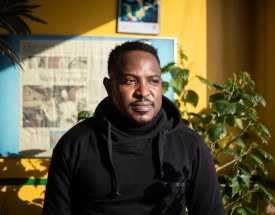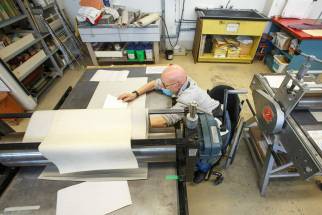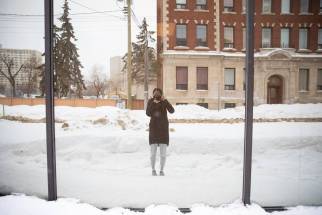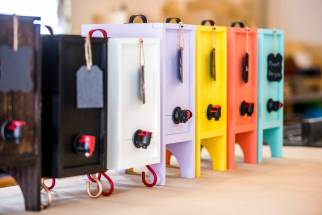Ramping up accessibility Audit aims to help arts venues improve service for broad scope of disabled patrons and artists
Read this article for free:
or
Already have an account? Log in here »
To continue reading, please subscribe:
Monthly Digital Subscription
$0 for the first 4 weeks*
- Enjoy unlimited reading on winnipegfreepress.com
- Read the E-Edition, our digital replica newspaper
- Access News Break, our award-winning app
- Play interactive puzzles
*No charge for 4 weeks then price increases to the regular rate of $19.00 plus GST every four weeks. Offer available to new and qualified returning subscribers only. Cancel any time.
Monthly Digital Subscription
$4.75/week*
- Enjoy unlimited reading on winnipegfreepress.com
- Read the E-Edition, our digital replica newspaper
- Access News Break, our award-winning app
- Play interactive puzzles
*Billed as $19 plus GST every four weeks. Cancel any time.
To continue reading, please subscribe:
Add Free Press access to your Brandon Sun subscription for only an additional
$1 for the first 4 weeks*
*Your next subscription payment will increase by $1.00 and you will be charged $16.99 plus GST for four weeks. After four weeks, your payment will increase to $23.99 plus GST every four weeks.
Read unlimited articles for free today:
or
Already have an account? Log in here »
Hey there, time traveller!
This article was published 25/02/2022 (1385 days ago), so information in it may no longer be current.
The music has ended, the house lights have risen, but Peter Tonge isn’t ready to leave. It’s not because he wants to meet the band or watch the musicians load out their gear. He would rather head out with the post-concert crush, but his accessible taxi hasn’t arrived yet.
“There’s nothing worse than everybody in the venue standing around wanting to go home and your ride isn’t coming for another hour,” says Tonge, a community consultant, wheelchair user and an avid concertgoer.
It’s an anxiety-inducing experience that could easily be remedied with a little more information from the concert venue.
“One of the small things that really helps is, for example, publishing ahead of time how long the show is, because people with disabilities often have to pre-arrange transportation,” he says. “It seems like a small thing, but it can really impact your experience.”

Tonge is the project lead for a new audit of arts venue accessibility released this month by Art AccessAbility Network Manitoba — a non-profit advocacy organization for artists and art patrons with disabilities. The goal of the audit is to encourage concert halls, theatres, galleries and arts groups to expand their idea of accessibility and look for new — often small — ways to accommodate a wider swath of audience members and creatives.
“The venue itself might be physically accessible, but typically, that’s sort of where it ends,” Tonge says, adding that while ramps and expensive renovations are one aspect, a more inclusive environment can be achieved through simple, low-cost fixes, such as an informative website, closed captioning and Braille signage.
“(Accessibility) is a very broad scope, considering all the various disabilities you might encounter,” he says.
The audit has been a year in the making and was created in consultation with Manitoba’s disability community — something that sets the 175-item document apart.
“Traditionally, when audits are created, they’re created by doctors, architects or so-called experts. The real experts of disability are those with lived experience; we know what we need to properly access the arts and different spaces.” – Jenel Shaw, executive director of the AccessAbility Network
“Traditionally, when audits are created, they’re created by doctors, architects or so-called experts,” says Jenel Shaw, executive director of the AccessAbility Network. “The real experts of disability are those with lived experience; we know what we need to properly access the arts and different spaces.”
Consultations took place over Zoom last summer with more than 40 artists and members of the public who identify as disabled, deaf, blind or neurodiverse. What emerged was a range of perspectives and some common themes.
“The one thing that we heard over and over and over again is that there’s a real lack of training of staff,” Shaw says.
Many people shared anecdotes about venue employees being unable to answer basic questions about a location’s accessibility features. “It doesn’t really create a very welcoming environment if people don’t expect you to be there.”
“We don’t want to go to venues and tell them all the things they’re doing wrong. We’re hoping to create relationships and open communication. No one is going to be fully accessible; it’s a work in progress.” – Jenel Shaw
While Manitoba has legislated customer service accessibility standards, the audit goes deeper — looking at both the front- and back-of-house operations — and offers an industry-specific resource for arts organizations. The purpose is to educate, not dictate.
“We don’t want to go to venues and tell them all the things they’re doing wrong,” she says. “We’re hoping to create relationships and open communication. No one is going to be fully accessible; it’s a work in progress.”
While operators can download the audit online (aanm.ca), the AccessAbility Network is also planning an independent review of 50 venues across Winnipeg. The findings — which will look at everything from the accessibility of auditoriums to tech booths to administration offices — will be posted as a database on the organization’s website.
Arts AccessAbility Network Manitoba Audit
Ted Howorth, a Winnipeg printmaker and wheelchair user, is looking forward to the database. Before heading somewhere new, Howorth travels virtually, using Google street view to ensure he can navigate the neighbourhood.
And that’s only part of the routine.
If he has tickets to a play, for example, the mental checklist is significant, “What’s it going to be like in the theatre? How am I going to access it? Am I going to be delivered by taxi or am I going to drive on my own? And if I’m driving, can I find a spot where I can park my car?” he says.
A one-stop online directory would do a lot to ease the logistical burden.
‘It will be fantastic,” he says. “Anybody who wants to interact with the arts will know they can look things up and find out what’s possible and what’s not possible.”
Howorth is a retired University of Manitoba art teacher who has been renting space at Martha Street Studio for years. Somewhat serendipitously, the East Exchange District studio and gallery has become more accessible as his mobility has declined over the last two decades.

The entrance to Martha Street is at ground level and there is a lift connecting the first and second floor; transcription and ASL services are also available for events and artist talks.
It’s an outlier in the historic neighbourhood, which is home to many of Winnipeg’s galleries and art institutions.
“There’s some spaces I just can’t get into,” Howorth says. On occasion, he’s asked friends to carry him and his wheelchair up flights of stairs to attend exhibits. “But that’s not what you want, you want to travel through life in the city as much as anyone else.”
Like Howorth, Fred Dugdale has also had to modify his art practice in recent years. A motor vehicle accident left him with a traumatic brain injury that has affected his ability to play stringed instruments and memorize lyrics. As a part-time musician who performs in several local bands, Dugdale has found ways to adapt. He’s taken up the harmonica, brings lyric sheets on stage and often wears sunglasses to mitigate the light sensitivity he’s developed owing to his injury.
“I’m not trying to be a rock star,” he says with a laugh. “For me, it’s a necessity, not a fashion statement.”

When booking a gig, Dugdale explains what accommodations he needs — such as stage-lighting adjustments — ahead of time. While venues are usually quick to comply, he recognizes that barriers still exist for others.
Dugdale has sat on many boards and committees with different disability organizations. He’s well-versed on the Accessibility for Manitobans Act, which became law in 2013, and says that while legislation is an important starting place, organizations should be looking at inclusion as a core part of their business model.
Within the local arts scene, Dugdale has been impressed with the accessibility features offered at the Winnipeg Folk Festival and the rise of relaxed performances — shows designed for audience members who may find the noise or lights of standard performances overwhelming — at the Winnipeg Symphony Orchestra, Manitoba Theatre for Young People and elsewhere.
“You can’t serve every need,” Dugdale says. “But you can do what is within your capabilities, both financially and in terms of making policy changes.”
Inclusion also makes financial sense, says Jenel Shaw of the AccessAbility Network. According to Statistics Canada, 22 per cent of Canadians have at least one disability.
Setting the scene
For Vivi Dabee, running commentary during a theatre performance isn’t distracting — it’s illuminating.
“It just makes the performance more vivid,” says the playwright and consultant for Sick + Twisted Theatre’s new live audio description service for audience members with sight loss. “I don’t have to wonder what’s happening onstage, because I’m getting that information in real time along with the rest of the audience.”
The goal of Vocal Image Ensemble Winnipeg, or VIEW, is to make theatre more accessible to blind or low-vision patrons. It’s a service Debbie Patterson, artistic director of Sick + Twisted, has wanted to bring to the city for a long time after encountering the concept in Vancouver.
“There probably isn’t a culture of theatre-going among a lot of vision-impaired people, I mean, why would you go? It’s a visual medium and it’s been excluding you,” Patterson says. “I think that audience will build as we go.”
Live audio description explains the visual elements of a play not usually included in dialogue. Costumes, set dressing, props and physical action — a pratfall or fight scene — fall into that category.
Previously, Dabee had to recruit friends or family members for the role.
“It’s an empowering experience to know that I can go to the theatre and that service is already in place,” she says. “And it’s going to be done well and by skilled practitioners.”
The VIEW team is made up of nine audio describers specially trained for the task. During performances, they sit in a discreet location and talk into a microphone fitted with a rubber mask to muffle their voice. Those sitting nearby won’t be disturbed, while clients can hear descriptions clearly through an earpiece.
To prepare for a show, the describers join in on rehearsals to learn the timing and blocking of a performance and create a script. The goal is to deliver succinct information without stepping on the dialogue. As a consultant, Dabee’s role is to take in described performances and offer notes on things that need more or different explanation.
The commentary should also match the style of the play and accurately describe actors — the latter requiring some input from the actors themselves.
“The politics of how you describe people is a fascinating aspect of it,” says Patterson, who took part in the local training sessions.
The service is currently available to theatres and performing arts groups and Patterson hopes to expand VIEW’s reach in the future.
“I’d love it if we were describing every show that happens in the city,” she says. “I’d also love it if we were describing things like Pride or the Santa Claus Parade or dance shows or doing museum tours.”
She’s also interested in offering pre-performance touch tours, where audience members can come onto the set and get a sense of the space.
VIEW has been describing some virtual shows amid the pandemic and is scheduled to accompany a live performance of Outside Joke: The Improvised Musical at Prairie Theatre Exchange in May. Visit sickandtwisted.ca/describers for more information.
“If you’re not being welcoming to that portion (of the population), you’re losing out on a fifth of your potential sales or patrons or artists,” Shaw says. “I don’t think people realize how many artists with disabilities there are.”
Her organization represents about 400 members across Manitoba working in visual arts, theatre, music, dance, poetry and writing.
Yvette Cenerini is one of those members and has enjoyed the opportunity to mentor and be mentored by other artists in the group. Accessible professional development can be hard to come by.
“Artists get to go to (residencies) and meet people from all over the country and have time to work and explore ideas and try new things,” says Cenerini, a digital collage artist and wheelchair user. “I would have to bring someone to help me take care of my basic needs… and travelling would be more complicated and all those things are also costly.”
At the moment, she’s content to stick closer to home and has been engaging with online artist workshops and exhibitions amid the pandemic. It’s a format she hopes sticks around for good.
“It’s so nice to be able to access that information… without having to put in all the effort to leave my house,” she says. “When you make things accessible for someone who needs it, it will automatically help someone else.”
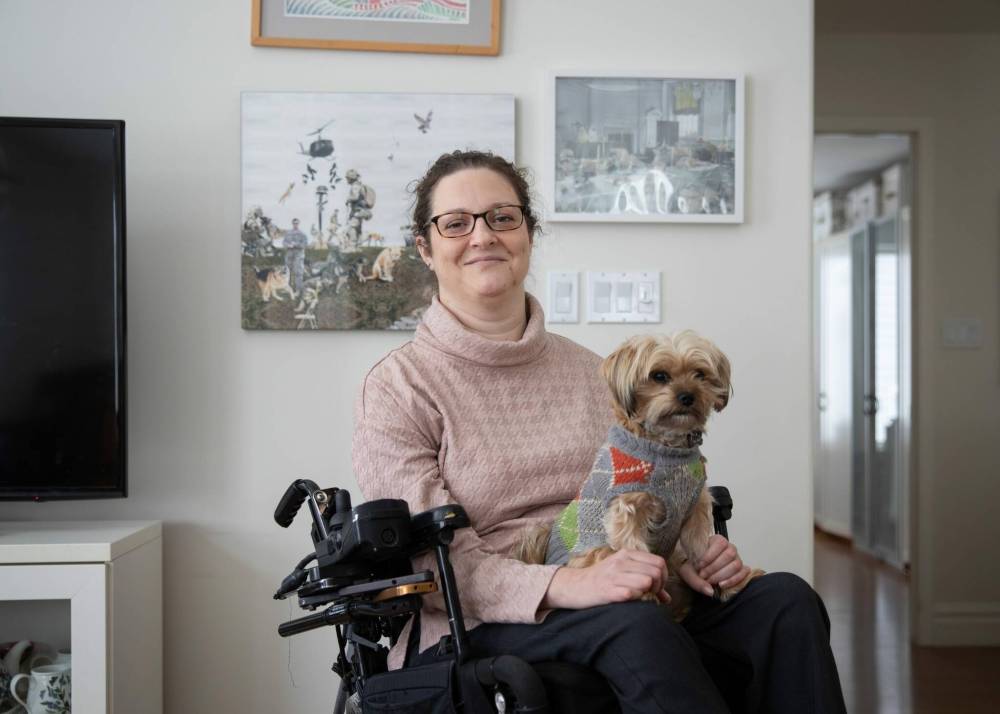
As an artist who shows her work in galleries, Cenerini has to relinquish a lot of control to curators, since she isn’t able to install her own exhibits. Relying on help from strangers is a challenge made easier by good communication and an understanding of disability protocols — such as asking for consent before touching someone’s mobility aid or speaking directly to an individual with an attendant.
“The more we talk about it, the more both sides will get used to asking for help and helping just the right amount,” she says, adding that the AccessAbility audit is a positive way to raise awareness about the different kinds of barriers that still exist in the art world.
The audit is intended as a jumping-off point and the network will be offering training opportunities for venues and organizations interested in learning more. Shaw is hopeful that the ideas presented in the document will create more opportunities for artists and art lovers with disabilities to participate in the local scene.
“Often, people with disabilities are not looking to be fixed,” she says. “We’re looking to embrace ourselves and show how these creative ways that we’re thinking and moving in the world can really create more access and discussion around what it means to be human.”

Our newsroom depends on a growing audience of readers to power our journalism. If you are not a paid reader, please consider becoming a subscriber.
Our newsroom depends on its audience of readers to power our journalism. Thank you for your support.





